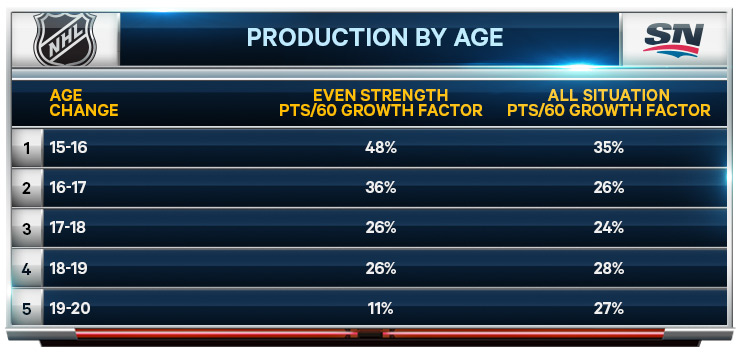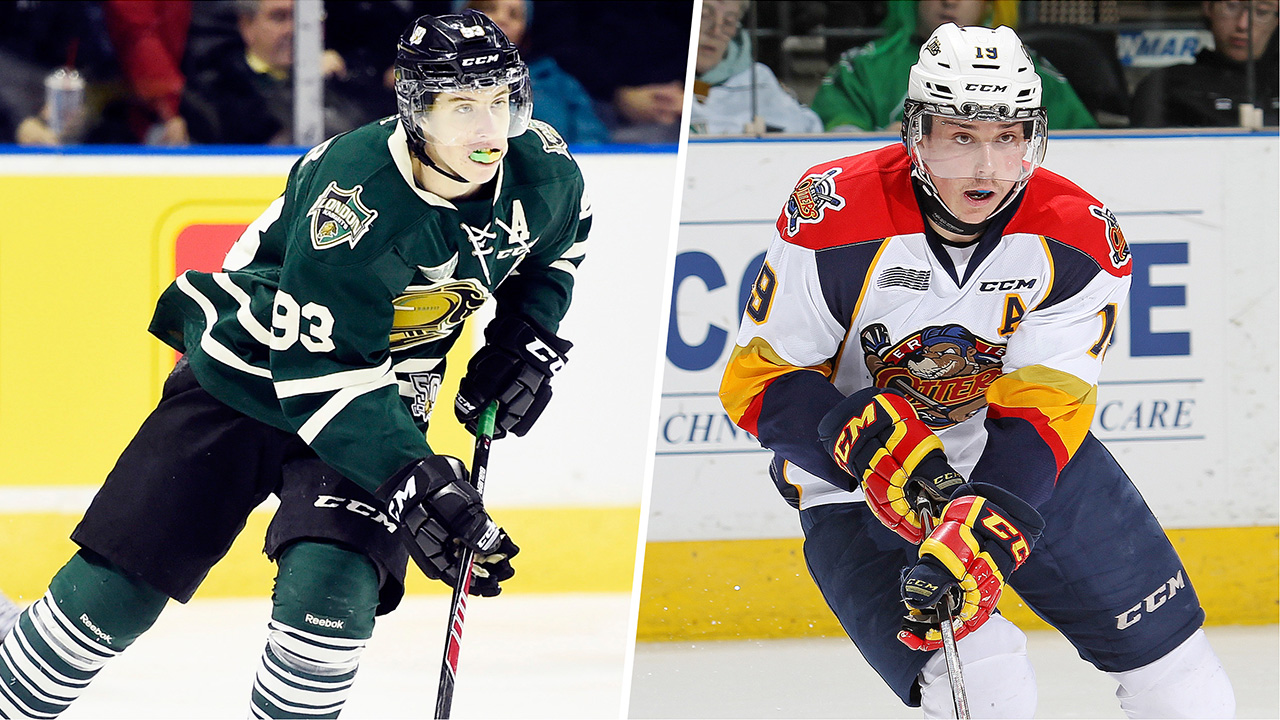Connor McDavid is going to be in the NHL with Edmonton this season, and he’s likely to produce at a solid level. Based on his junior-age production, he is arguably the best skater to depart the CHL since Sidney Crosby a decade ago. McDavid’s draft-eligible season production of 2.55 points per game ranks second all time for OHL skaters under the age of 18 to Eric Lindros’s 2.61.
But hiding some in McDavid’s shadow were Dylan Strome and Mitch Marner, who finished 1-2 in OHL scoring on the backs of two of the most impressive draft-eligible CHL seasons in history. Marner’s 126 points came courtesy a 2.00 points-per-game average and Strome’s 129 thanks to a 1.90 mark. Skaters with that level of OHL production tend to have very lengthy and productive NHL careers, often as top-line producers.
Marner and Strome’s averages rank 11th and 20th in OHL history for skaters under the age of 18. Others in that range include: Jason Spezza (2.07 pts/g), Joe Thornton (2.07), John Tavares (2.00), Kirk Muller (1.92 pts/gp), Owen Nolan (1.91) and Jeff O’Neill (1.91). For the sake of recent comparison, consider that both outpaced Steven Stamkos (1.72), Tyler Seguin (1.68) and Sam Bennett (1.60) fairly significantly.
Marner (Maple Leafs) and Strome (Coyotes) were drafted by NHL clubs with numerous question marks on their rosters, and both would be best served by a return to the OHL to continue to hone aspects of their games. Toronto has gone into full rebuild mode and the revamped front office has made clear its plans to develop players more rigorously before promoting them fully to the NHL. Similarly, Arizona is restocking the cupboards with young talent after a number of seasons floating on the outer edges of playoff contention in the Western Conference.
So what do we have to look forward to from Strome and Marner in their draft-plus-one seasons? To analyze their probable performances we can look at other skaters as they have aged to identify probable production ceilings and floors.
Skaters in the CHL predominantly play from ages 15 to 20 and tend to see their production increase year-over-year as they develop both physically and skill wise, while also seeing increased opportunities to contribute. Using data from CHLStats.com, the shift in performance is most obvious when we track scoring rates based on production per 60 minutes of play.

Due to a lack of available data, tracking time on ice for CHL players is a bit murky. It can only be estimated based on participation in on-ice events. That means we may actually over-estimate the amount of time elite players see and under-estimate it for middle-of-the-road skaters. If so, that shortchanges elite talents who would then actually be producing in even less ice time than estimated.
The key age range we are looking at is from 17- to 18-year-old seasons. The chart below shows CHL production rates for 49 forwards selected in the top-50 in their draft-eligible seasons compared to their draft-plus-one campaigns, with estimates for Marner and Strome for the sake of comparison.


Obviously it is more of a challenge for 17-year-old elite talents to improve on the numbers that got them drafted highly in the first place than it is other players. On average, CHL skaters see a roughly 25-percent increase in point-production rate the season after they’re drafted. But that is an over-estimate for the elites generally, who already have seen regular deployment in offensive scenarios and must deal with roster turnovers that see them losing top teammates.
Marner and Strome will be expected to carry the offensive load without the support of Max Domi in London and McDavid in Erie. That being said, Strome will have the benefit of playing with 2016 draft-eligible Alex DeBrincat who posted 104 points, and ran away with CHL rookie-of-the-year honours. In London, Marner will have two of the top-five ranked 2016 draft eligible prospects in Matthew Tkachuk and Max Jones on his team. So neither will lack for offensive weapons to play alongside.
Assuming both play top-line minutes and see lots of power-play time they should average around 26 minutes a game. But with previews at NHL training camps and inclusion on Canada’s world junior squad, neither is likely to play more than 60 regular-season games. If they play 55 at 26 minutes per night, both should produce somewhere between 118 and 131 points this season, again putting them in firm contention for the OHL scoring title.
Even if they aren’t playing in the NHL this season, Marner and Strome will have a much brighter light shone upon them in the OHL as they attempt to reach the super-high bar they set for themselves in 2014-15. Maintaining the same level of output will be a challenge, any improvement will show significant strides.


